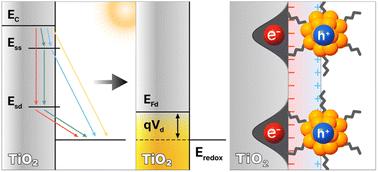纳米团簇/TiO2界面处光照诱导的深阱态激活:敏化太阳能电池中本征光电容的起源
IF 7.4
1区 化学
Q1 CHEMISTRY, MULTIDISCIPLINARY
引用次数: 0
摘要
贵金属纳米团簇(NCs)在光电化学系统中显示出新的功能。这项研究揭示了金属纳米簇敏化太阳能电池(mcssc)本质上可以作为光电容器,在黑暗中储存电荷。Au22(SG)18 nc敏化TiO2的光照激活了深层表面陷阱状态,形成了一个界面电容,负责持续的暗内置电位。开路电压衰减实验证明了一个稳定的暗电压后照明,这种现象在应用偏置电压衰减实验中是不存在的,突出了NCs内光生孔在充电电容器中的关键作用。提出的模型以TiO2深阱为负极,谷胱甘肽配体为电介质,NC核(承载孔)为正极。在没有外部存储组件的情况下实现的这种固有的光电容行为,在敏化太阳能电池中是前所未有的。这些发现为NC/TiO2界面动力学提供了深刻的见解,并表明mcssc是集成太阳能转换和存储的候选材料,为新型光电容器的设计铺平了道路。本文章由计算机程序翻译,如有差异,请以英文原文为准。

Illumination-induced deep trap state activation at the nanocluster/TiO2 interface: the origin of intrinsic photocapacitance in sensitized solar cells
Noble metal nanoclusters (NCs) in photoelectrochemical systems reveal novel functionalities. This study unveils that metal nanocluster-sensitized solar cells (MCSSCs) can intrinsically function as photocapacitors, storing charge in the dark. Illumination of Au22(SG)18 NC-sensitized TiO2 activates deep surface trap states, forming an interfacial capacitance responsible for a persistent dark built-in potential. Open-circuit voltage decay experiments demonstrate a stable dark voltage post-illumination, a phenomenon absent in applied-bias voltage decay experiments, highlighting the crucial role of photogenerated holes within NCs in charging this capacitor. A proposed model features TiO2 deep traps as the negative electrode, glutathione ligands as the dielectric, and the NC core (hosting holes) as the positive electrode. This intrinsic photocapacitive behavior, achieved without external storage components, is unprecedented in sensitized solar cells. These findings offer profound insights into NC/TiO2 interfacial dynamics and suggest MCSSCs as candidates for integrated solar energy conversion and storage, paving the way for novel photocapacitor designs.
求助全文
通过发布文献求助,成功后即可免费获取论文全文。
去求助
来源期刊

Chemical Science
CHEMISTRY, MULTIDISCIPLINARY-
CiteScore
14.40
自引率
4.80%
发文量
1352
审稿时长
2.1 months
期刊介绍:
Chemical Science is a journal that encompasses various disciplines within the chemical sciences. Its scope includes publishing ground-breaking research with significant implications for its respective field, as well as appealing to a wider audience in related areas. To be considered for publication, articles must showcase innovative and original advances in their field of study and be presented in a manner that is understandable to scientists from diverse backgrounds. However, the journal generally does not publish highly specialized research.
 求助内容:
求助内容: 应助结果提醒方式:
应助结果提醒方式:


